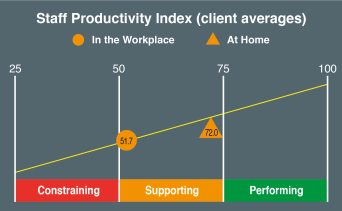Hybrid Working Solutions
What is hybrid working?
Hybrid working is a flexible working model that offers employees the autonomy to choose to work wherever and however they can be most productive. This means that staff can make decisions about which of in-office, remote and on-the-go working is best for them on a day-to-day or even hour-to-hour basis.
Hybrid working means that work is now truly something you do, not somewhere you go.
Organisations need to respond to the implications of this change as teams and staff seek to find their 'new normal' working model.
is changing substantially and workplaces need to respond to support, and to continue to support, the needs of the workforce.
Workplaces to support a hybrid working workforce, will be far different from pre-COVID workplaces:
- New work settings will be required to facilitate new activities including remote meeting attendance
- The proportions of space set aside for each type of work setting will be significantly adjusted to accommodate new staff preferences and working habits
- As the ratio of staff to desks increases - making desks more scarce
- A new operating model for the shared workplace will be needed to ensure fair and easy access for all
Some of your space can be surrendered or sub-let, as overall property economies can be realised because much of the organisation's workplace has moved to the workforce's homes
Take a look at our Hybrid Working and Post-pandemic Workplaces
For almost 15 years we have been measuring the indicators of staff productivity in the workplace through in-depth quantitative, and qualitative, staff surveys.
At the start of lockdown in 2020, we adapted our staff survey to enable us to compare our in-office benchmark with home working performance levels.
Averages hide significant edge case variations within and across clients of course, but if your staff are now performing considerably better from home than they were in the office, then we want to make sure you harness that improvement - and re-plan your central workplaces accordingly
Our figures - spread across all our clients - show (see graphic) that the average employee is substantially more productive from
home that he/she is from the office.
This result is reinforced by staff's own perception that they are more productive from home.
Workplace Futures Staff Survey
Our 'Workplace Futures' staff survey will enable you to identify
- Your staff Productivity Index level compared with our benchmark
- Identify those staff/groups who have most need of the office
- And those who have little if any need
AND crucially: - We identify the type of activities which will draw your staff back to the office - and how often
- How that 'draw to the office' can be encouraged or discouraged
- And how your central workplaces should be planned to accommodate the new requirements
Post-pandemic Workplaces
Post COVID-19 lockdown workplaces are new to all of us. No matter what staff say, or predict, they will do, their preferences and behaviours will evolve. And then they will evolve further as they become affected by the preferences and behaviours of their team mates, peers and managers.
The future workplace must adapt to these changing requirements so it is important to be prepared for changes. Activities we are performing - right now - to inform the evolution of the workplace:
- Reviewing workplace utilisation
- Tracking the overall demand for central workplaces
- Tracking utilisation levels of all space types
- Identifying which space types staff prefer for which activities
- Reviewing staff feedback on in-office workplace satisfaction and productivity indicators
Contact us now to hear how we are partnering with organisations to plan their exit strategy including prepare their workplaces for a social distancing return to work.






